Following up on my post last week on what Noel Odell could see on that fateful day, June 8, 1924.
I’ve been doing a lot of thinking about it recently, and have come back to a theory which hit me on April 28, 2001, as Brent Okita and I moved up the North Ridge toward the 1924 Camp VI, while following a similar path to Odell 77 years before. I fairly quickly dismissed it as folly, for everything seemed to point to Odell seeing Mallory and Irvine on either the First, Second, or possibly Third Steps. (In October 2021, I was reminded of this old thoughts by a comment from a reader, Milos, on an old Odell post.)
Odell himself vacillated on this many times in his life, but overall seemed fairly set on the climbers being on the Second Step. The issue with this, as has been written and discussed at length, is that he saw them only for a brief time, and in that brief time - maybe five minutes at most - he saw them move from the base of a great rock step, and on to the top.

I’ve struggled with this for decades: How could this timeline make sense? Put simply, it doesn’t. The timing, the description, it just doesn’t add up. Let me explain a bit more:
- The First Step could possibly match Odell’s sighting, but it is tough for climbers today - with oxygen, fixed lines, and a known route - to ascend it in five minutes; Mallory and Irvine of course did not know the route (which is not obvious), had no fixed lines, and were using a rudimentary-at-best oxygen system. Additionally, the mountain, from what I can tell, was fairly dry up high in ‘24, much like it was in 1999, when there was little snow on the First Step to accentuate the climbers Odell saw.
- The Second Step is where most of us - myself very much included - have long wanted to believe Odell saw them, for if they were seen atop it at 12:50 PM, there almost no chance they did not make the summit, for at that point all the difficulty would be behind them. But, again, it doesn’t quite add up. The only place on the Second Step where it would be feasible for Odell to have seen them is on top of the Step, or on the direct ridgeline of the Step, which is not a feasible line of ascent. And, Odell noted that he saw them at the base and then the top. Seeing them at the base would be impossible as it’s too dark, and additionally there’s no conceivable way they could climb the Step - or even the final portion of it - in five minutes.
- The Third Step has been offered up many times, but again it does not really quite make sense to me. First off, Odell was fairly adamant throughout his life that he saw them on the Second Step. Additionally, while it’s the only Step that could realistically be climbed in 5 minutes, it doesn’t align with Odell saying he saw them on a snow crest leading up to the Step, as the Third Step does not have a snow slope at its base.
So, where did Odell see them? I can’t say for sure, but I’ve come back to the old idea I had 22 years ago. I think it likely that Odell did see them on the Second Step, or at least what he may have considered to be part of the Second Step.
Let me explain my thinking a bit: While perhaps not official names, the first two steps it seems were noted as such in 1924. In The Fight for Everest, Norton writes of the Northeast Ridge route: “There was always the doubt that a feature in this route, which we called the second step, might cause considerable difficulty…” (Emphasis mine.) Note his language - which we called - indicating that referring to the Second Step as such was common on the expedition. So, we can infer that Odell - and everyone else - knew the First and Second Steps by those monikers.
Interestingly, though, in his accounts, Odell does not say he saw them on the Second Step. Rather, in the official account, he says he saw them on the “last step but one from the base of the final pyramid.” If it was the Second Step, why didn’t he say that, write that? Why, instead, did he say “the last step but one?” Perhaps because the point he was referencing was not the First Step, and not the Second Step, and not the Third Step - which is never referenced in 1924 and essentially dismissed as a non-obstacle - but instead the last but one?
Take a look at this photo, taken in 2001 from a similar vantage point to Odell in 1924. The First and Second Steps are clearly defined, clear as day. Between them, though, just beyond Mushroom Rock, there is another feature - a rock hump with a snow slope on its northern aspect. Could this be where he saw them? Could this be the “last step but one?” And, if so, why would Mallory and Irvine have been on that feature?

First, it seems to line up with what Odell said in Fight for Everest 1924:
I noticed far away on a snow slope leading up to what seemed to me to be the last step but one from the base of the final pyramid…
- Noel Odell in Fight for Everest 1924 (on Archive.org)
The rock hump has a snow slope on its north (left hand) aspect. It seems, from a distance - from where climber’s like Mallory and Irvine would stop to take a break and take stock - to lead up to the Second Step.

And, if the Second Step is the last step, and the First Step is before it, but there is another, less obvious step-like feature between the two, could it not be therefore the “last step but one?” It seems reasonable.
On the second question - why would Mallory and Irvine possibly be there? - that makes more sense with a visit to Mushroom Rock, a prominent and obvious feature just before it. From Mushroom Rock, the modern route dips considerable below the crest of the Northeast Ridge, climbing the Second Step not from the crest but from well below, using the “Corkscrew Chimney” to access the snowpatch beneath the final headwall. But, this is not obvious, not simple, not at all appetizing, and hard to imagine Mallory and Irvine figuring out this route on the first try.
More likely, from Mushroom Rock, they would be enticed to continue along the crest of the ridge, if for no other reason than to scope out the terrain ahead, get a good view of the Second Step, and see how on earth they might climb it. While it seems counterintuitive to us to go this way - because thanks to a century of climbing it we know which way to go - it would make a lot of sense for Mallory and Irvine to do so. Continuing on the Ridge from Mushroom rock is a more natural, logical route at first blush than descending below along the narrow shelves and exposed benches of the modern route.
Take a look at the photos below to get a better idea:
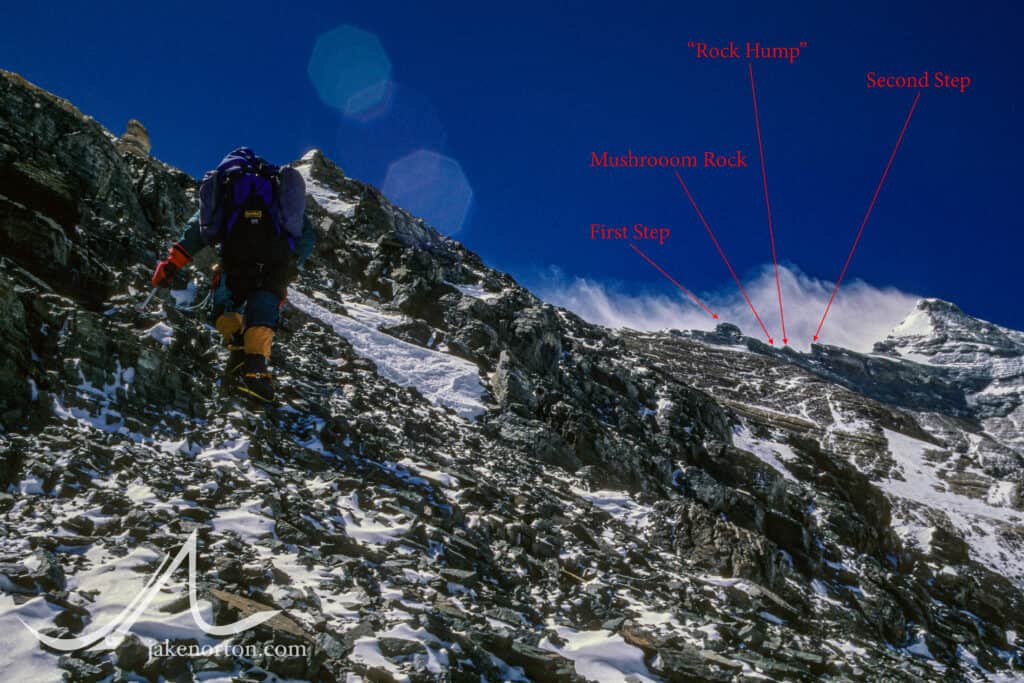
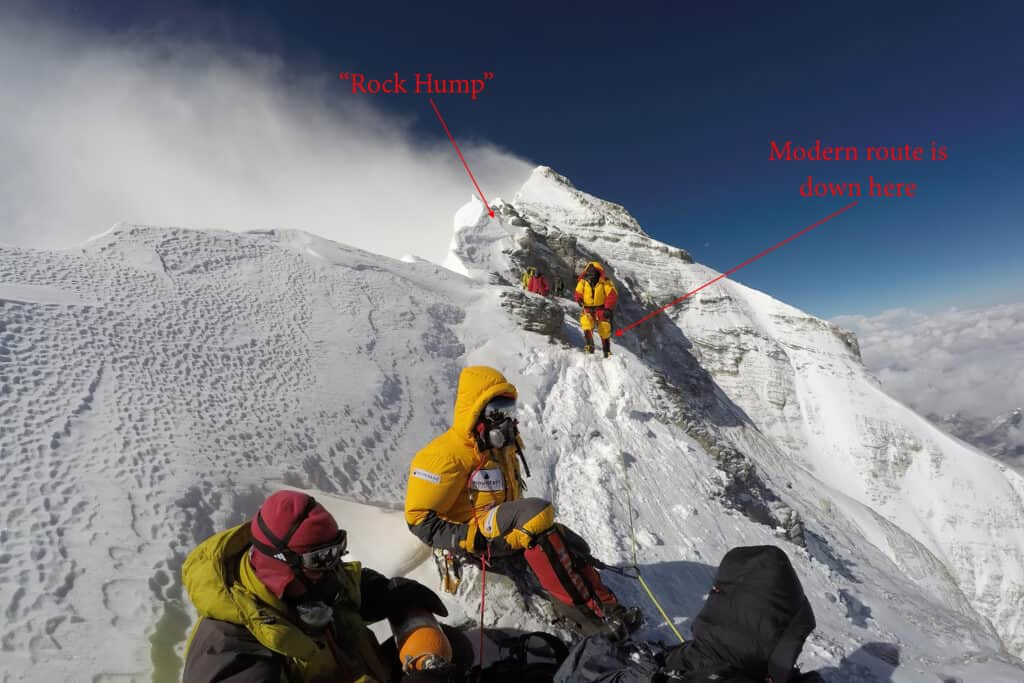
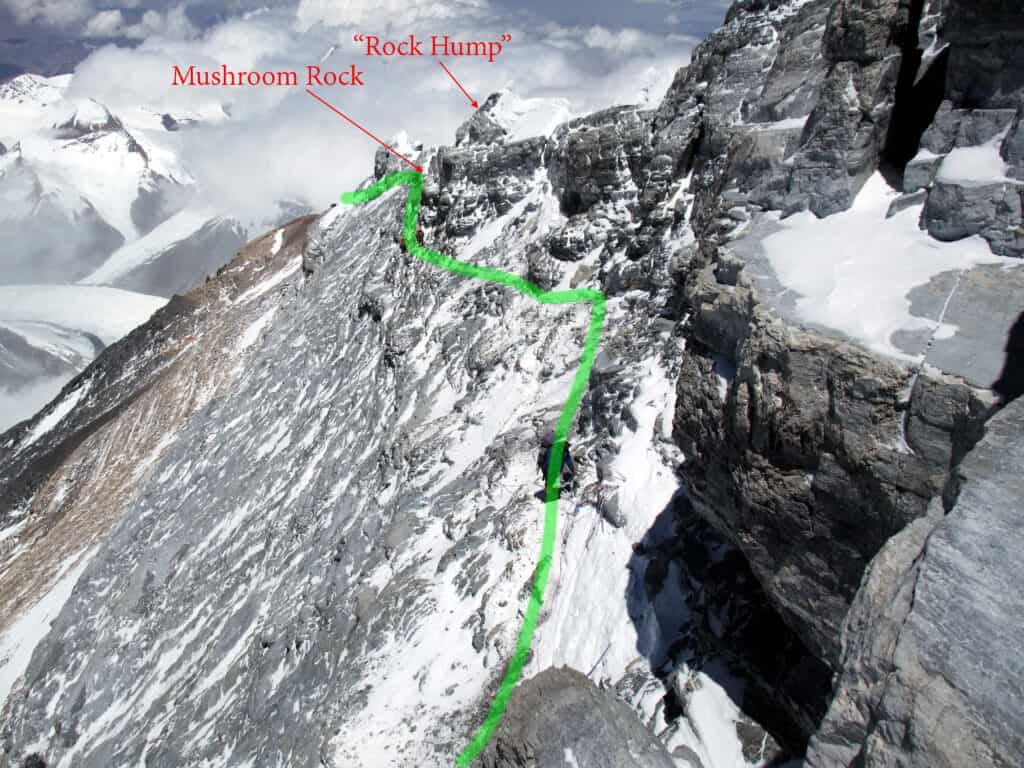
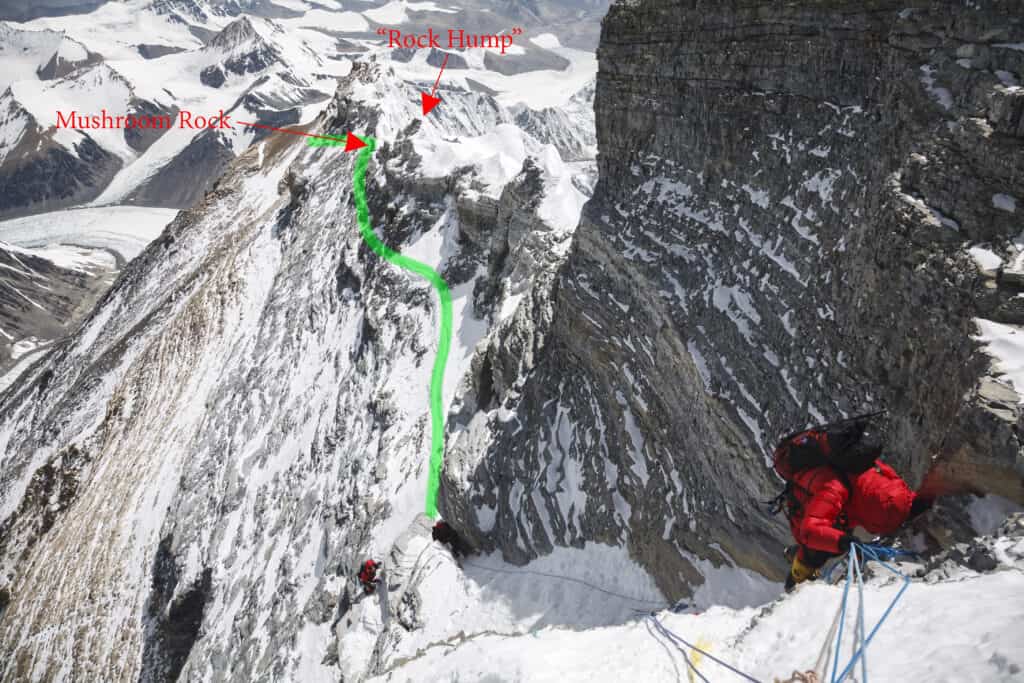
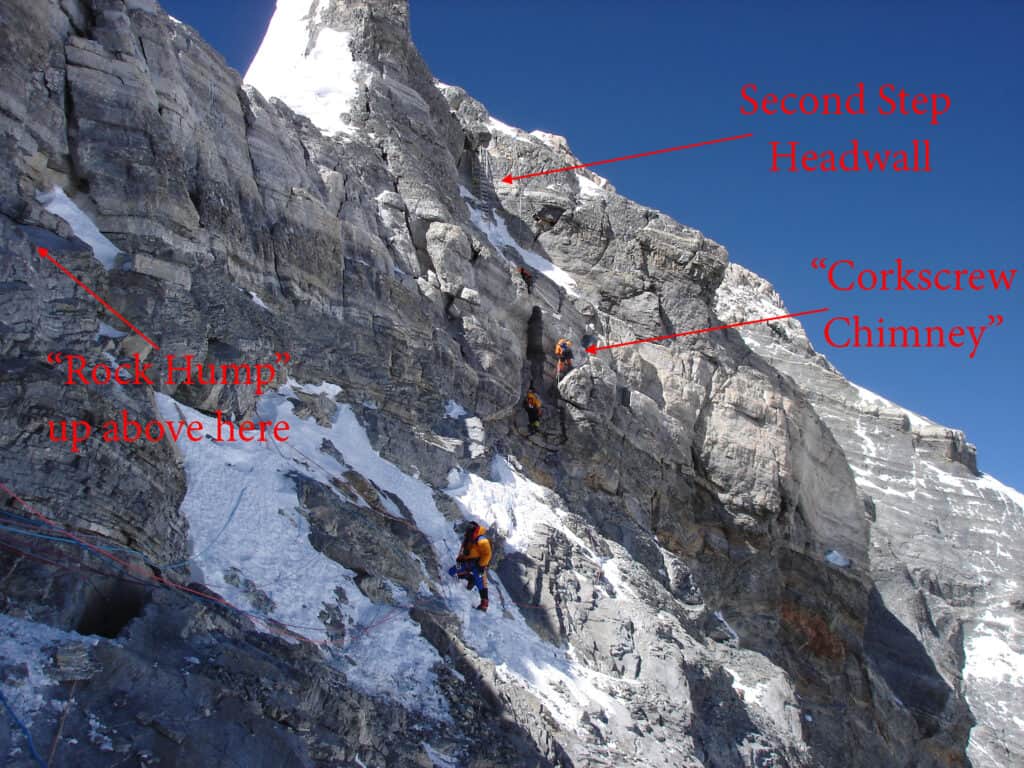
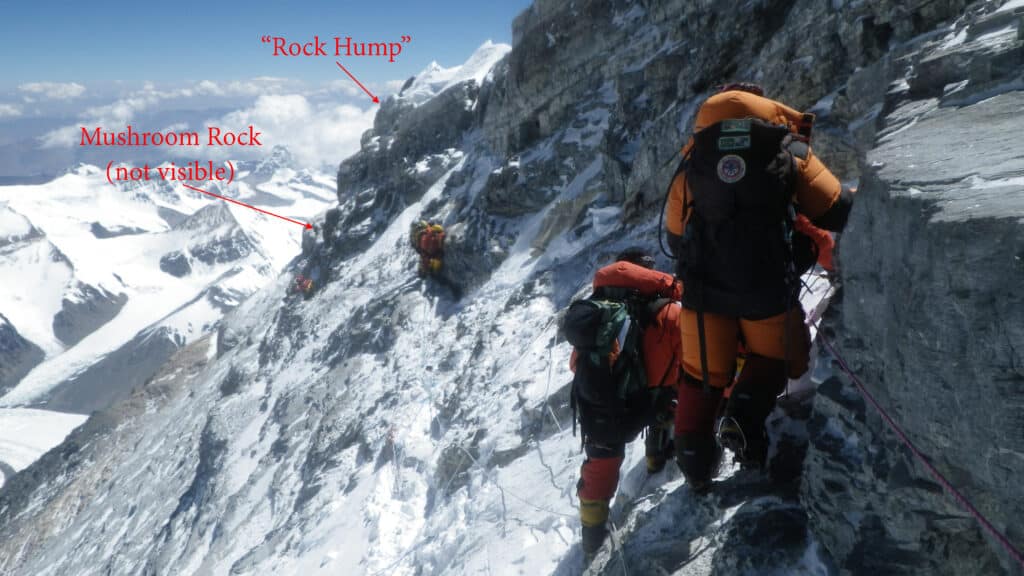
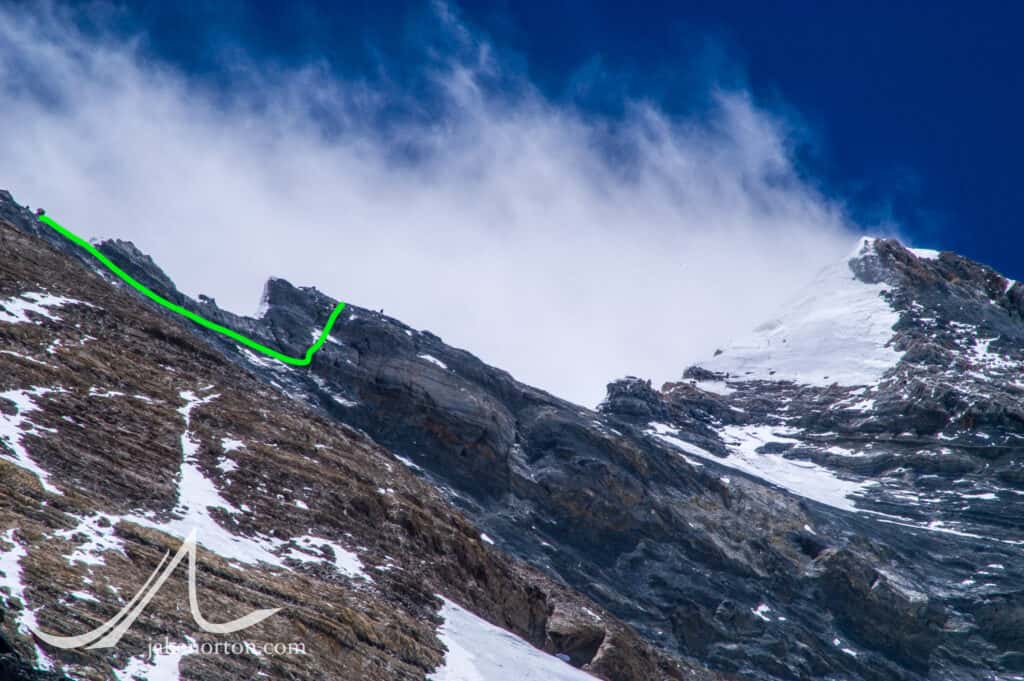
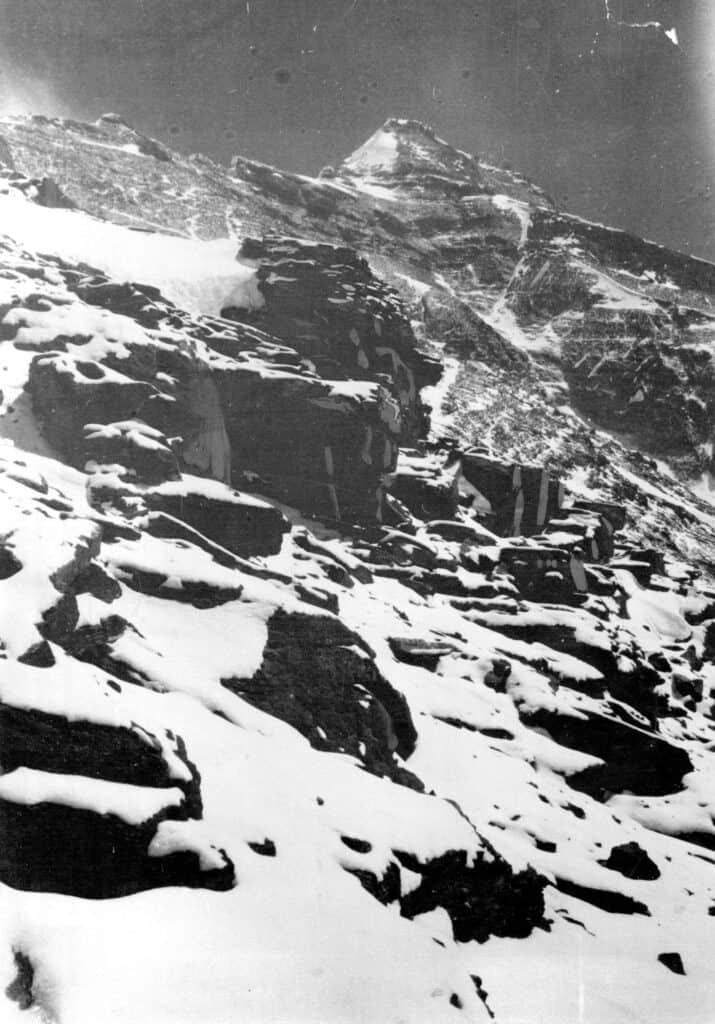
So, what of it?
To be honest, I’m not entirely sure. There are some out there who would prefer a definitive statement, a conclusion one way or other saying Mallory and Irvine had to have been here, there, or elsewhere. They must have done this, gone this way, picked up this or that, etc. Unfortunately, all of that is hogwash, mere conjecture. All we know is actually quite minimal: They left Camp VI, at some point they left a trail of gear beneath the First Step (a mitten, an ice ax, and an oxygen bottle), and they were last seen at 12:50 PM by Odell.
Do I know this is where Odell saw them? Of course not. It’s just a hunch, a thought, an idea that perhaps adds some fodder to the already rich pile of ideas surrounding their final days and hours. And, perhaps someone with a better brain, better eyes, and less preconception than me can turn my “observation to some account for the purposes of” history.
What do you think?
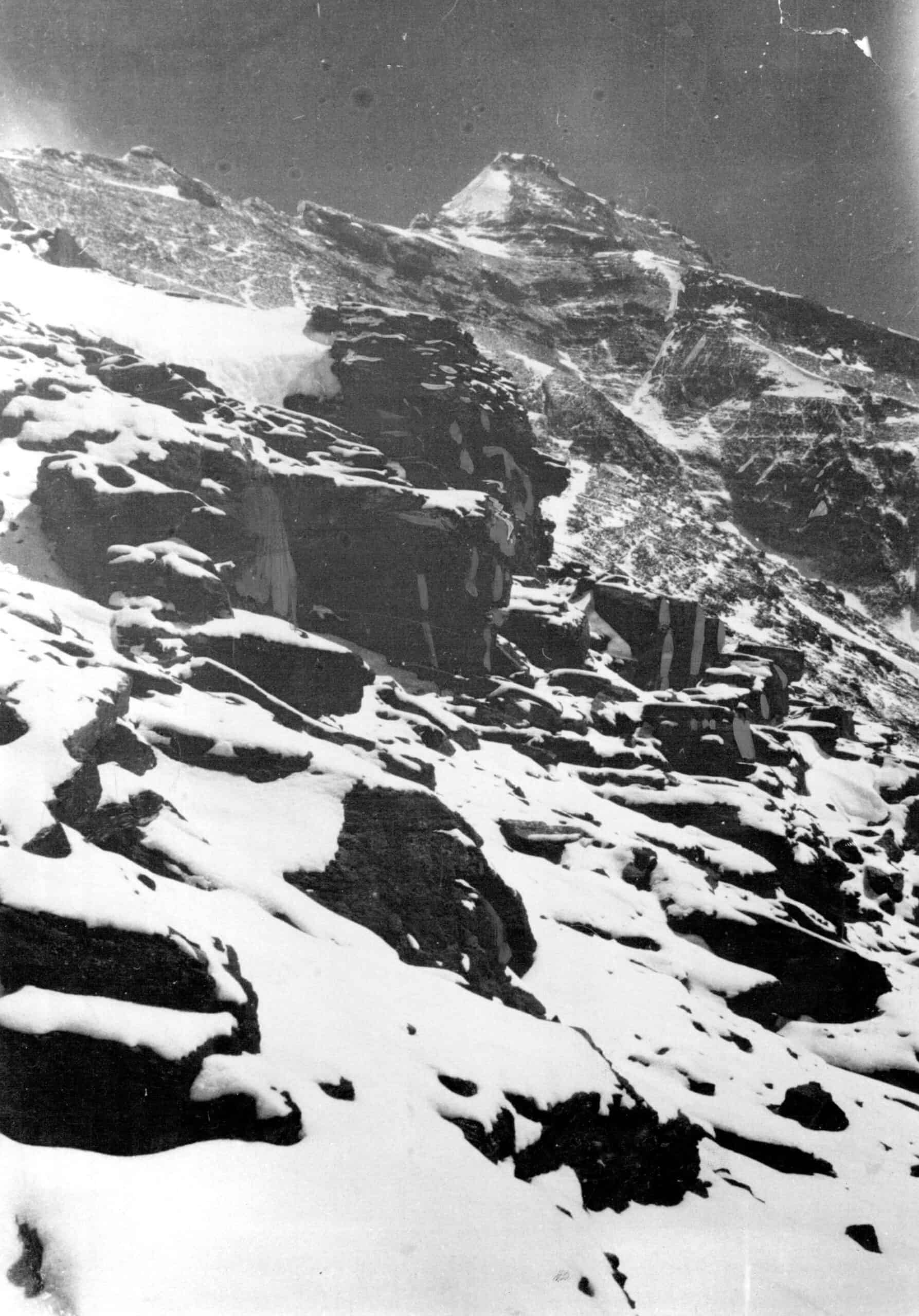
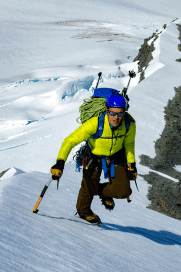

This is exceptional! Very exciting. Great work Jake
Greetings Jake. I've a few thoughts on this ... perhaps he said 'last step but one' because there was not yet a definition of the Third Step as ..., well, the Third Step! There does seem to be another hump past the Third Step where the modern route now goes off to the right before going up. Also, I've read of some divergence of opinion on what constituted the 'final pyramid' then (and now?), the idea being that the 'final pyramid' was the clear triangular block that is visibly distinct from the whole mound above the rock band. Given Mallory's great length of time on the mountain, his well-documented route finding skills and his obsession with the mountain, I really doubt he would have gone to the top of the First Step or your 'rock hump', because those clearly just go up and then down and there would be no reason to do that. Still, of course, none of us know and it is endlessly fascinating.
Looking at the pic of the 2nd step and the terrifyingly sheer drop down the north face makes me think, "No way!". Mallory broke his leg, perhaps while attempting the 2nd step, or on the way down the north face with Irvine trying to lower him down. The only way to find out is to locate Irvine's body. Probably covered with rocks by the Chinese.
I think we can rely on Odell's words. "The Last Step but one... "
Which means that they never got past the second step, I am not a mountaineer , but all the photos of it look terrifying !
I read the second article the day you published it, it's a magnificent series, there are no more riveting and honest presentations on the topic especially with visual support from photographs. I waited for others to comment first as i tend to have a less enthusiastic view on the fate of Mallory and Irvine. I accept the story based on Odell's sighting more as a panegyric in homage to their great adventure rather than verifiable history. Life ends in death for everyone, but in actuality few people really come to term with their future certain death decades ahead of its natural expected time (you kind of need an external trigger to do that like a serious illness, or living through the time of the great plague, the death of a close relative or living through a big war on the front. It is the latter that the two Englishmen experienced). Once you have, you no longer feel apprehension for your own death but rather seem to channel through and connect with the universe while alive and understand that this link will not be lost in death.
I think an important part of the story of Irvine and Mallory is to exalt the glory of the spirit of adventure. Like the Odyssey of Greek Ulysse whom we don't know was a fictional or historical character who made a big journey to the ends of the earth and almost died many times, people love such lyrical stories, panegyrics of great chiefs. Imagination holds a big place in it, as it does in Irvine and Mallory's final ascent. At some point the story moves from history to myth to better serve the living as the dead no longer need historical accuracy.
Sometimes such stories become exaggerated, emphatic praise, in an entertaining funny way : "to carry them above the eighteenth firmament. O my minister, I hold you at last! I can perfume you with the pastilles of the seraglio of praise, embalm you with a panegyric of my preparation !" (Reybaud,J Paturot,1842).
I had another strange idea, while writing this comment, a board game could be created based on Mallory and Irvine's Everest climb with several possible outcomes, random factors from dices rolling and picking from a deck of cards and making the right choices along the path. When the game starts, six hidden cards must be picked by each player each a major challenge or good fortune that will be unveiled during the game. Some combination will decide the death in advance (just like a sudden change in weather, and insufficient gear, or an avalanche and lack of visibility, rock falling etc) but not be known to the player until that time comes. Other players may see the challenges of other players but not theirs, and at some point there must be a form of help between the players to succeed. A player may save another in exchange for beeing allowed to drop one of their challenge. etc..
Back to Odell, the psychological impact of having to climb down knowing his companions died, can have a strong effect including memory confusion where actual belief and reality become intermingled. Then there is the well known english expression "to keep up the appearances at all costs".
One would have to study how the british reported world war 1 casualties to get an idea of how willing they were to represent the truth when it's defeat. All to say that i don't entirely rule out the possibility that Odell convinced himself first, then the others that the two climbers had been were he wanted them to be. How worried was he already at the time of his sighting ? They were already much behind schedule and in his mind maybe not vividly but knowingly, he might already have counted their fate as almost sealed. In such state of mind seeing a mirage is possible. Often what happens is such situation is that something that actually happened earlier is altered and taken out of context and re-situated in a fictional setting and may not have occured at the given time but earlier. For example he might have seen Mallory and Irvine much earlier in the day when they were only 1 hour away from his position but with the shock of their imminent disparition he ended up believing to himself (and to keep up appearances) that he saw them much later and much higher up. In such situation the person truly does not believe they are lying, reality becomes blurred. I believe that cannot be entirely ruled out.
The hard facts, their last possessions found, a pick axe, an oxygen bottle and only one mitten could already foretell a bleaker story. Who would get rid of a mitten such an essential item to avoid frostbites ? to climb a rock face ? I think it's a small indication but a possible indication that things had already gone astray, and i cannot but think of stories of climbers with altitude sickness who started removing their clothes. Also the abandoned pick axe looks like an act desperation to me. I think that they succumbed to exposure and did not have all their mind to themselves their final hour, or was it just one of them. How high did they get ? I would think possibly above the first step at the most. But it does not matter and does not diminish their achievement, the odds stacked against them were enormous and only seen in hindsight, they didn't know. That's the idea for the board game.
I believe the story doesn't end there. Maybe the Chinese have revelations to make or maybe not..
Or maybe Irvine is still somewhere on the mountain waiting for that day when someone will find him and the camera.
Back to a previous thought, there were four steps. From where Odell was, the rock band across the bottom of the triangular snow patch on the pyramid could be considered to be a step. I believe that is not actually the "final pyramid", the final is hidden behind this one. This understanding would have them on the Third Step as the last step but one. If it was me, I would have climbed the Third Step to get a better view of possible routes. They were the first up there, there was no established route and a major problem is getting a good view of what is before one. I think they took the Sommerville-Norton route, zig-zagged to the Third Step. From there, there is little doubt they could have made the summit and back in good weather. However, they were last seen enveloped in cloud. I have been enveloped in cloud. You can't see your hand at the end of your arm. Wayfinding is difficult. Issue in doubt.
Jake, I admire the quality of your work and your passion for this story.
Merci beaucoup, Pierre, et un Joyeux Anniversaire très en retard ! J'espère que vous allez bien, et j'espère vous revoir bientôt ! (Did Google do a good job? My Mom would be horrified that I'm using Google to speak French!!)
Faszinating thinking, Jake - and an idea that has occasionally came up over the years, namely by Walt Unsworth in "Everest" and, if I remember correctly, by Frank Smythe. I do disagree on one point: You state that "the Third Step does not have a snow slope at its base". When I watched Conrad and Dave approaching the Third Step on May 17, 1999, they crossed a distinctive stretch of snow, which from my position low down on the East Rongbuk Glacier (approx. along the same line of sighting as Odell) looked like part of the ridge crest. It is hidden by the upper edge of the Second Step in your wonderful shot from Camp VI, but it is just visible from the North Ridge - so perhaps in Odell's sight, who was between the two locations.
Thanks, Jochen, as always for your great input and thoughts. I was unaware (or my aged brain just forgot it) that Unsworth and Smythe both noted the same possibility. I'll look for those, but would love it if you have references for those, too. To me, it really does make a lot of sense, and is a place/feature where Odell could easily have seen them. As for the Third Step, I see what you mean - the snow patch is slightly visible (I think it's what you're referring to) in this crop-shot from about Odell's location on the N. Ridge, and totally not visible in this crop from Camp VI. Ah! So many unknowns!
Hi Jake.. just one more question..
Is it true that Chinese found some oxygen bottles above second step ?
There is some mention of that
Hi Vukasin,
I'm not aware of any confirmation that the Chinese found pre-WWII bottles about the Second Step. I've heard rumors over the years, but they turned out to be only that. Do you have documentation of where that came from? If found, that would be ground breaking information!
Thanks,
Jake
Showell Styles proposed this same theory , in his book Mallory of Everest , page155.
Published in 1967
Hi Jake
What about the 'base' being the actual top of the second step as the 2nd step continues to the summit pyramid.
A relatively 'easy' walk of 5mins would take them to the base of the summit pyramid!
Regards
Ken
Other than Odell's cryptic sighting, why do people assume M&I went up the modern ridge route? On the immediately previous attempt, Summervell and Norton had made excellent progress along the yellow band, and were only turned back because of lack of oxygen, and Mallory knew this. With the tanks that Irvine and Mallory had, there is no reason they would have gone off on a brand new route, rather than proceed along the tried-and-true path that Norton opened, pushing it further. Remember, Mallory knew Irvine did not have the climbing skills to ascend the Second Step, so why did he bring him as his partner if he intended to go that way?
When Mallory's note said "It won't be too early to start looking out for us either crossing the rockband under the pyramid or going up skyline at 8(am)", it seems pretty clear that he was intending to start along the rockband, then (if the going was too hard, probably for Irvine), go up to skyline. That puts him far past the Second Step. And that route would have been within the abilities of Irvine, with Mallory's assistance.
I think all the discussion about 'could he have done the Second Step' is tunnel vision based on the known current route, and a false assumption.
Hi Myron, thanks for your note and comment. I agree, somewhat, that there has been a situation of blinders on with regard to the Northeast Ridge, without much consideration being given to M&I following Norton and Somervell's route, or finding an alternative.
That said, I think many are now getting an equal case of blinders on about the Couloir and proposed "zig-zag" route up to the Third Step and summit pyramid. In my view, there's evidence pointing to either route and option, depending on how one chooses to read and interpret data, and what one wants to believe and wants to discount.
As for Norton and Somervell only being turned around due to lack of oxygen, that is not the case. Somervell stopped early due to rough breathing from a constricted throat. That ailment was thanks to partially freezing his larynx in the cold, and he nearly choked to death on the lining later on the North Ridge, saving himself by doing the Heimlich on his ice ax. After Somervell stopped in the Yellow Band, Norton continued along, making good progress, not complaining about having no oxygen, and turned around in the Couloir only after encountering steep slabs covered by unconsolidated, sugary snow which he felt climbing alone represented a fool's errand. So, it was not an oxygen issue, but rather an issue of route conditions (new snow) and difficulty (steep, slabby terrain). This is essentially the same reason that, 9 years later, exceptional climbers Wager, Wyn-Harris, and Smythe all turned around in nearly the identical spot as Norton.
While I'm not saying M&I did not opt for the Couloir route, there are some substantial gaps in the reasoning behind this thought. Why would Mallory, an experienced and adept climber, follow Norton's route only 4 days after Norton turned around due primarily to bad snow conditions? He would have known that the snow would not have changed much in that time period. Additionally, if this route is such a great option, as has been suggested, why weren't Wager, Wyn-Harris, and Smythe able to find passage through it? Why did Messner not go that way in 1980, or Larry Neilson in 1982, or McCartney-Snape or Ershler in 1984? I think the reason is that the route through there is extremely difficult. And, of course, if we are to believe Odell saw at least something, somewhere, on the NE Ridge at 12:50 PM, then M&I would have had to find a way through from the Couloir up to the Ridge/Pyramid, which, based on the above, seems hard to imagine. We'd also need to ask why, if the Couloir is such a fine route, did the Chinese choose to climb via the Ridge in 1960 and 1975, and why has that been the route of choice ever since? Logic would say if an easier route existed, it would have been chosen at some point along the way.
Compare this to the NE Ridge. With the exception of the Second Step, the NE Ridge is a fairly benign route. Not simple, but not epic. Much of the climbing can be done safely, especially in hobnail boots on the slabs. We know that Mallory & Irvine were up there at some point thanks to the O2 bottle Tap Richards found in 1999 and the mitten I found in 2001. As for the Second Step, I don't quite understand why some believe M&I could not have climbed a 12-15 foot headwall (difficult but short and, depending on who you believe, likely within Mallory's climbing ability) but could have found an unknown route through quite sketchy terrain above the Couloir.
Anyway, as you can see, I bristle a bit when assumptions are put out as facts. We know, sadly, quite little about what transpired on June 8, 1924, about where Mallory and Irvine did and did not go, what they did and did not say or do or think, etc. It's great to debate all of this, but at the end of the day you and I and all the others are debating with scant few facts and huge packs full of assumptions. Hope this makes some sense, and thanks again, Myron.
Hi Jake, at the Second Step I always thought that there could be a way around the nose on the ledge lower on the right, basically following on top of the light grey band that contains the corkscrew chimney. From certain angles it looks like it could be a very delicate but do-able traverse, especially on hobnail boots. I have never been there and cannot judge it, perhaps you have some thoughts about that? Would be extremely exposed. But once around the corner the ledge broadens and would lead directly to the lower area you searched in 2019.
Would be nice to hear your thoughts.
Thanks!
Hi Jake. I thought that a problem for Norton and Somervell was water as well as oxygen. They intended to leave at 6:00am, but spilled water at Camp VI had to melt more snow to get a litre each - which is too little considering the cardio involved - and hence set off at 6:40am instead. Norton got to his highest point at noon.
I think the Second Step is a redherring as an observation and a route on numerous counts. It does not accord with the time of 12:50pm for the Odell sighting, as far too long to get there from 6:00am. Also what Odell saw is far too short a time to ascend it. Odell’s first description accords more with the final (3rd step).
There’s also the lack of dumped oxygen bottles and the lack of dumped oxygen carrying gear, dumped somewhere as not on Mallory’s body, for 2nd Step to have been the end point.
There were contemporaneous vested interests in ruling out M&I having got to the top. Noel Odell died at 96, but maintained the possibility that Mallory and Irvine had succeded, despite pressure from colleagues on the Everest Committee: it was easier to fund subsequent attempts if it was held that the summit had not been reached by M&I. Norton had a double interest 1) making subsequent attempts more likely 2) preserving his altitude record. Odell’s sighting on 3rd step would automatically override Norton’s altitude record only 2 days old.
It was the health of Norton and Somervell -as well as oxygen expertise - that meant Irvine was the partner of Mallory for the third attempt of 1924.
If Mallory chose to follow Norton’s route better prepared and with oxygen then he would know he could have got to Norton’s turn back point before noon. Hence consistent with Odell’s sighting of 12:50pm. It was Norton who changed Odell’s story to 11:00am to fit with 2nd step. Being on 2nd step at 12:50pm would have been obvious mission failure. And why take Irvine on that route?
Finally Norton wrote a book in 1924. He would have had to give himself third ranking had M&I got to a higher altitude than him, even worse if he contemplated they’d got to the top. The 2nd Step nonsense helped put him centre stage. An appoach entirely consistent with his being senior in the British Army at that time! Not to mention that Mallory had liberal left of centre politics and was a member of the bohemian and pacifist leaning “Bloomsbury Set”. Most/all of the ‘evidence’ of “Second Step” leads to Norton.
You mention the description not matching the third step - but it matches it to a tee.
We need to look at Odell's statement right after the sighting, that is the most precise:
''The place on the ridge mentioned is a prominent rock step, at a very short distance from the base of the final pyramid'
and what he said in the original expedition dispatch
“There was a sudden clearing of the atmosphere, and the entire summit ridge and final peak of Everest were unveiled. My eyes became fixed on one tiny black spot silhouetted on a small snow-crest beneath a rock-step in the ridge; the black spot moved. Another black spot became apparent and moved up the snow to join the other on the crest. The first then approached the great rock-step and shortly emerged at the top; the second did likewise. Then the whole fascinating vision vanished, enveloped in cloud once more. There was but one explanation. It was Mallory and his companion moving, as I could see even at that great distance, with considerable alacrity … The place on the ridge referred to is the prominent rock-step at a very short distance from the base of the final pyramid.”
There is, from that perspective no other option, especially as it is snow covered. The description of two figures rather quickly ascending a snow slope with a rocky top is exactly what we see on the 3rd step and it is the step one can ascend quickly. It is also the step which is close to the final pyramid, nobody can say the 1st step is close, let's not be silly...And the second has no snow slope, and your intermediary suggestion (thought provoking as it is) just isn't close to the final pyramid. I think it's very clear from Odell's words what he meant
Mark Tracey's video showing Odell's exact perspective basically cleared this up for me. I'd be interested to hear your thoughts if you saw it.
Hi Zeb, your explanation is probably the best and most clear of all! We need to look at what Odell said and concentrate carefully on his wording, and it becomes as clear as day!
As far as I know no one used the term "second step" DURING the expedition. One would have to show me some contemporaneous account designating it as such. Norton calling it that later in his account, even claiming"that's what it was called", is not credible for me. Tracy has the first step obscured by his visual account of Odell's position, which is pretty precise. Others can hash it out with him.
What strikes me about Odell's sighting are four things. He seems genuinely startled, even excited they seemed so close to the final pyramid. Two he notes a small snowfield below the point. Only fits third step. Third, they were moving "with alacrity" and relative ease. Four, "last step but one" is not to be used with today's geographic and tehnical designations. It could easily be our "third step and "but one" is the pyramid itself. First impressions before political pressures emerge usually ar the most accurate.
You and Tracy agree they could not be seen at second step because it is too dark vusually and too difficult to climb with ease. First step timeline is off for their ascent rate.
Thank you so much for all of the work you have done here. This is the greatest adventure mystery of all.
Would love to hear more, if you have anything to add, about some of the terrain on the face below the ridge. I have to set up my question with a paragraph though.
It seems to me that both then and in more modern times, one attempt after another that traversed the face were effectively funneled into the same spot, which to a climber says it is a very intuitive if not obvious path of low resistance. I have also looked at the proposed zig zag route and, as much as I want to believe in it, at the critical spot near the couloir, the area above looks like a horribly down-sloping holdless bulgy nightmare from every photo I've seen, despite it not being steep. It's the sort of rock terrain we never want to encounter (and should be beyond Irvine).
But in a hypothetical where Odell is indeed describing them near the third step, in your opinion is there a higher variation of the traverse possible that avoids the nastiest-looking stuff? Mallory had the beta on the traverse and he would know it ends in technical snow/ice climbing that his summit party would probably not be able to do (or nightmare slabs). If Mallory innovates and finds a higher route that stays closer to the ridge, it's possible the Third Step is gained more easily. And the routefinding complications that would arise could account for the late hour at which Odell sees them (assuming they were climbing strongly as it seems they were).
Basically, is it plausible that they find a unique path across the face, or does this grand traverse have one way to go? Or is this more of an open question? This explanation if true could be consistent with a story of the evidence in a way that other explanations are not, and without major problems as far as I can tell. But I can only see so much in a photograph and I'm not going up there myself!
Cheers